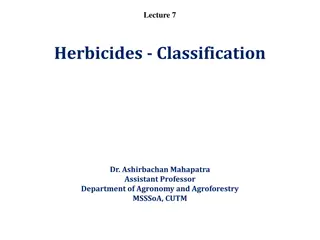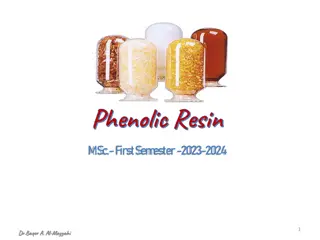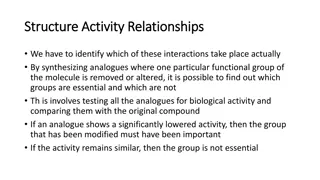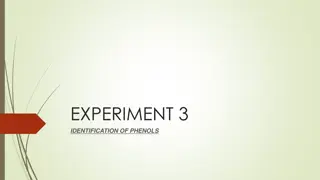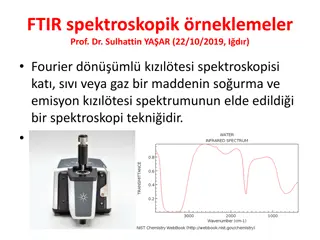
Phenols: Structure, Nomenclature, and Properties
Discover the world of phenols, compounds with the general formula ArOH where the OH group is directly attached to an aromatic ring. Learn about the structure, nomenclature, classifications, and physical properties of phenols. Explore the importance of phenols in pharmaceutical and pharmacological compounds.
Download Presentation

Please find below an Image/Link to download the presentation.
The content on the website is provided AS IS for your information and personal use only. It may not be sold, licensed, or shared on other websites without obtaining consent from the author. If you encounter any issues during the download, it is possible that the publisher has removed the file from their server.
You are allowed to download the files provided on this website for personal or commercial use, subject to the condition that they are used lawfully. All files are the property of their respective owners.
The content on the website is provided AS IS for your information and personal use only. It may not be sold, licensed, or shared on other websites without obtaining consent from the author.
E N D
Presentation Transcript
Phenols 1 340 Chem 1st 1439
2 Structure of Phenols Phenols are compounds of the general formula ArOH, where Ar is an groups. Phenols differ from alcohols in having the OH group attached directly to an aromatic ring. phenol is the specific name for hydroxybenzene, and it is the general name for the family of compounds derived from hydroxybenzene. OH OH Benzylalcohol -OH is not directly linked to the aromatic ring carbon Phenol -OH is directly linked to the aromatic ring carbon 340 Chem 1st 1439
3 Many pharmaceutically and pharmacologically important compounds, either of natural or synthetic origin, belong to this class of compounds, e.g. salicylic acid and quercetin. O H O H O H H O O H O 2C O H O H O S A f o r a s p i r i n a l i c y l i c a c i d n a n a l g e s i c , a n d a p r e c u s o r Q A u e r c e t i n n a t u r a l a n t i o x i d a n t 340 Chem 1st 1439
4 Nomenclature of phenols The simplest member of this class of compounds is named phenol. Others can be named as substituted phenols, and also retain by the IUPAC system. Numbering of the ring begins at the hydroxyl-substituted carbon and proceeds in the direction that gives the lower number to the next substituted carbon. Substituents are cited in alphabetical order. OH OH OH NO2 O2N NO2 NH2 Br NO2 IUPAC Common 4-Aminophenol p-Aminophenol 4-Bromo-2-nitrophenol p-Bromo-o-nitrophenol 2,4,6-Trinitrophenol Picric acid 340 Chem 1st 1439
O H O H O H 5 I U P 2 - M e t h y l p h e n o l C C o m m o no - C r e s o l A 3 - M e t h y l p h e n o l 4 - M m - C r e s o l e t h y l p h e n o l p - C r e s o l O H O H O H C H O C O O H i n o - 5 - c h l o r o p h e n o l C l N H 2 I U P A 2 - H y d r o x y b e n z a l d e h y d e2 - H C C o m m o no - H y d r o x y b e n z a l d e h y d eo - H S a l i c v l a l d e y d e y d r o x y b e n z o i c a c i d 3 - A m y d r o x y b e n z o i c a c i d S a l i c y l i c a c i d 8 O H 5 O H 9 O H 1 0 3 1 1 - N a p h t h o l 2 - N a p h t h o l 9 - P h e n a t h r o l - Naphthol - Naphthol 340 Chem 1st 1439
6 Classifications of phenols. Dihydroxypenols Polyhydroxypenols 340 Chem 1st 1439
7 Physical properties of phenols phenols are liquids or low-melting solids and colorless. The presence of hydroxyl groups in phenols means that phenols are like alcohols. For example, they are able to form strong intermolecular hydrogen bonds, and therefore have higher boiling points than hydrocarbons of the same molecular weight. Phenols are also modestly soluble in water because of their ability to form strong hydrogen bonds with water molecules. H O T o l u e n e P h e n o l o p b 1 1 0 . 6 C o p b 1 8 2 C 340 Chem 1st 1439
Acidity of phenols 8 phenols are more acidic than alcohols, and weaker acids than carboxylic acids Phenol is a strong acid than alcohols because the negative charge in oxygen is dispersed by resonance through the benzene ring. 340 Chem 1st 1439
The inductive effect of an electron-withdrawing group such as chlorine changes the charge distribution in the molecule so as to decrease the electron density of the ring and oxygen, causing the proton to be held less strongly; it also can stabilize the phenoxide ion by dispersing its negative charge. These effects make the substituted phenol more acidic than phenol itself. 9 The inductive effect of an electron-releasing group (i.e., CH3) changes the charge distribution in the molecule so as to increase the electron density of the ring and oxygen, causing the proton to be held more strongly; it also destabilizes the phenoxide anion by intensifying its negative charge. These effects make the substituted phenol less acidic than phenol itself. OH OH OH OH OH NO2 O2N O2N NO2 NO2 NO2 OCH3 Picric acid 2,4,6-Trinitrophenol Phenol 4-Nitrophenol 2,4-Dinitrophenol 4-Methoxyphenol p-Cresol (Common) pH 10 pH = 10 pH = 7 pH = 4 pH = 0.25 340 Chem 1st 1439
Preparation of phenols 10 Hydrolysis of diazonium salts Diazonium salts react with water in the presence of mineral acids to yield phenols. NO2 NH2 N2HSO4 OH HNO2 H2SO4 Sn HNO3 H2SO4 H3O HCl + H A r - N2 + N2 + H2O A r - O H NH2 N2HSO4 OH NaNO2 H2SO4 + N2 H3O 340 Chem 1st 1439
Alkali fusion of sodium benzene-sulphonates 11 SO3H SO3Na ONa OH H2SO4 H3O NaOH H2O NaOH 350oC SO3, heat S O 3H O N a O H H 3O N a O H 7 0 % o r K O H 3 0 % o 2 5 0 - 3 5 0 C Hydrolysis of chlorobenzene (The Dow process) C l O H O N a H+ C l2/ F e C l3 1 .d ilu te N a O H 3 0 0oC / 3 0 0 0 p s i 340 Chem 1st 1439
12 Oxidation of isopropylbenzene O O H O H + O O H 2 + H O o o H P O , 2 5 0 C 1 3 0 C 2 3 4 C u m e n e C u m e n e h y d r o p e r o x i d e B e n z e n e P h e n o l A c e t o n e or C l + H C l A l C l3 I s o p r o p y l b e n z e n e B e n z e n e
Reactions of phenols 13 Phenols undergo electrophilic substitutions. In phenol, the substitutions take place in ortho and para positions. Salt formation via strong base or active metal Williamson ether synthesis Ester formation Friedel-Crafts acylation: Fries rearrangement Halogenation Coupling with diazonium salts Kolbe-Schmitt Carboxylation Reimer-Tiemann reaction 340 Chem 1st 1439
14 340 Chem 1st 1439
Salt formation via strong base or active metal 15 With active metals: O N a O H N a + H 2 With bases S o d i u m p h e n o x i d e CH4< NH3 < CH=CH < ROH < H2O < ArOH <H2CO3 <RCOOH < HF O N a O H N a H C O N a O H 3 N R + H 2 O
Williamson ether synthesis 16 Phenol, a poor nucleophile, reacts with sodium hydroxide in the aqueous phase to form the phenoxide ion, a good nucleophile. Alkyl-aryl ethers can be synthesized by treating the sodium salt of a phenol with an alkyl halide.
Formation of Esters From Phenols 17 nucleophilic substitution
Reaction of aromatic nucleus of phenol 18 Friedel-Crafts acylation Acylation acyl chloride or anhydride/AlCl3 electrophilic aromatic substitution acyl chloride or anhydride (fast) nucleophilic acyl substitution Sulphonation O H O H O H S O3H H2S O4 1 0 0oC H2S O4 1 5 -2 0oC S O3H 340 Chem 1st 1439
Nitration OH 19 OH OH OH O2N NO2 NO2 Dil. HNO3 Conc. HNO3 Conc. H2SO4 + NO2 NO2 Halogenation FeCl3 2,4,6-Tribromophenol 340 Chem 1st 1439
Aldehyde formation: ReimerTiemann reaction 20 340 Chem 1st 1439
Carbonation: Kolbe reaction 21 340 Chem 1st 1439
Oxidation of Phenols 23 Phenols are more easily oxidized than alcohols. Oxidation of compounds of this type with silver oxide, potassium dichromate K2Cr2O7 or with chromic acid H2Cr2O7 yields conjugated dicarbonyl compounds called p-quinones (1,4-benzoquinone). O H O N a2C r2O7 H2S O4, H2O O H O H y d ro q u in o n e p -B e n z o q u in o n e (7 6 8 1 % ) O H O O H O A g2O e th e r 4 -M e th y lp y ro c a te c h o l 4 -M e th y l-1 ,2 -b e n z o q u in o n e (6 8 % ) (4 -m e th y l-1 ,2 -b e n z e n e d io l) 340 Chem 1st 1439

